First World War Project
William Allan SEWELL (of Lynsted)
b. 5th February 1894 Lieutenant, Service Number N/K |
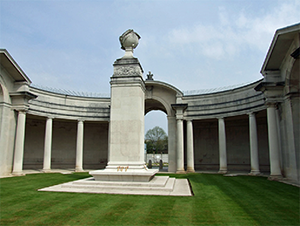
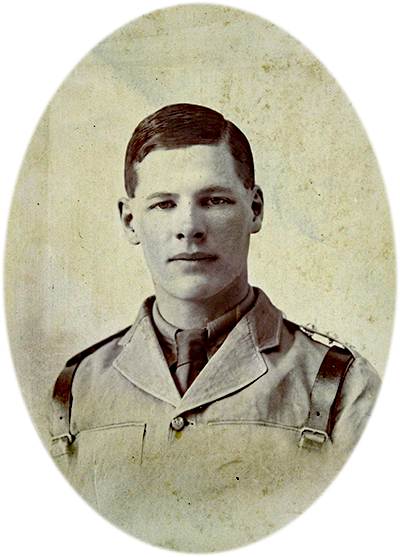
© Keble College, Oxford University
William (known as Allan, and now referred to as such) was born in Lynsted Vicarage on 5 February 1894 and christened in Lynsted Church on 4 March. He was the sixth child and youngest son of Reverend Thomas Jackson Sewell MA, the vicar of Lynsted, and Augusta Cecilia (née Taylor). Allan's five elder siblings were, Clarence John Threlkeld (known as Keldie), who predeceased him, Arthur Taylor, Thomas Jackson Elliott (known as Elliott), Frederick Charles (known as Charles), and Margaret Cecilia. His two younger siblings were Veronica Mary and Hannah Dorothy. Thomas also served in WW1 in the Royal Garrison Artillery, was wounded and awarded the Military Cross.
Reverend Sewell was originally from Kirkby Stephen in Cumbria, and, with his two brothers had entered the Church. A graduate of Queen's College, Oxford and, prior to becoming vicar of Lynsted on 18 July 1891, had been a curate at St Mary's Church, Faversham. It appears that, although a charming man, Allan's was a strict authoritarian Victorian father. He was considered at home to be severe sometimes, it seems more so after the death of his eldest son Keldie. He was ambitious for all his children teaching each of them up to secondary school age and the younger ones beyond that. But the family also had a lot of fun walking and cycling for miles around the Kentish countryside. We are told that Allan was the most fun of all the brothers being a bit of an adventurer. A short piece on his siblings is included at the end of this biography.
Allan entered Keble College, Oxford, in the Michaelmas Term of 1913 and became a member of the University Officers' Training Corps. He enlisted in the army as Private 2221, 4th (Cumberland and Westmorland) Battalion (Territorial), Border Regiment, this being the local regiment of his family. The battalion moved to Sittingbourne in September 1914 and it is probable that Allan enlisted there while home from Oxford for the summer. On the outbreak of war, Keble College transformed itself into an Officer Training Unit and it is likely this is where he undertook his officer training. On 10 November 1914, he took up his commission and became a 2nd Lieutenant.
Allan would now have joined the newly formed 2/4 Battalion in Blackpool, where training began in earnest. Training comprised route marching, musketry, bayonet fighting and night operations. According to the battalion war diary there were problems. Although all these tasks were "enthusiastically tackled", this in spite of "the shortage of rifles and equipment, which proved the most serious obstacle to training, the shortage of rifles especially relating to musketry training". The battalion also undertook shore-patrol due to increased activity of German U-boats in the area.
In January 1915 the battalion was called to proceed to France. This order was then cancelled and, in February 1915, the battalion asked for volunteers to sail for service in Burma. Every man volunteered, including those too young to serve overseas.
On 3 March 1915 the battalion left Blackpool for Avonmouth at which time their eventual destination was again changed. Allan sailed from Avonmouth for India on 4 March 1915.
Hours later, just after midnight, the HMT Dongola collided with an anchored Belgian steamer in the Bristol Channel, being holed below the waterline forward on the starboard side. The troops, stores and equipment were transferred to HMT Tunisian and on 7 March they continued on their journey only to have to stop engines and turn off lights outside the harbour due to the presence of a German U-boat. Just before midnight they were able to move but, on the point of sailing, there was an electrical fire. Thankfully this was put out by the crew. The following day the battalion suffered its first casualty when an officer on board died of meningitis and was buried at sea.
On 31 March, the ship docked in Bombay and troops were entrained to Poona. The battalion was still in need of training, especially in musketry. Therefore, it was not until 12 November that Allan's "B" Company proceeded to Kirkee as a relief detachment. Then on 30 November, they headed to Fort Allahabad.
In January 1916, the battalion proceeded to Shankargarh for company training. Early March saw Allan move to Peshawar, where he would remain encamped opposite the Punjabi lines until the beginning of May when they moved into barracks. Here the battalion remained, undertaking escort duties and standing in reserve, until 30 November, when they moved into camp near Taikal Cemetery. It was here, on 2 November 1916, Allan was made Temporary Lieutenant.
Early in 1917, the battalion proceeded to Bara for the "Kitchener Test". This was considered, even by the regular soldiers, the severest test a British soldier could face. It was undertaken by all ranks after a period of physical and technical training. Consisting of 3 days of simulated actions of war, on iron rations (a small amount of emergency food), with each element of the test scored:
1. Battalion march 15 miles with 100 rounds ammunition followed by attack on a position. 200 marks.
2. Scouting and outpost duty day and night. 300 marks.
3. Attack and defence of position. 800 marks.
4. Duties of bivouac. 150 marks.
5. Night operations. 150 marks.
6. Rear-guard, 10 miles. 150 marks.
7. Transport duties. 120 marks.
8. Physical condition. 100 marks.
9. Miscellaneous duties. 80 marks.
Marks to be deducted for:
1. Deduction of 1 mark for every man falling out between elements 1 to 6.
2. If Third Class Shots exceed 12%, minus 10 marks for each %-age increase.
3. If men continuously hospitalised for alcoholism or "general disease" exceeds 10 in 1000, 5 points were deducted for each 1 per 1000 excess.
In addition, there were additional points available through extra competitions, such as football, or tests. There was considerable rivalry between battalions/regiments and a Board of Officers decided the eventual winners and presented the cups and trophies.
With the conclusion of their training, the battalion was now mobilised, along with the 5th Gurkhas, to Sadar Garhi to relieve the Durham Light Infantry on the Mohmand Blockade Line. Here the Blockhouses came under frequent attack and sniping. But Allan's time with his battalion was coming to an end.
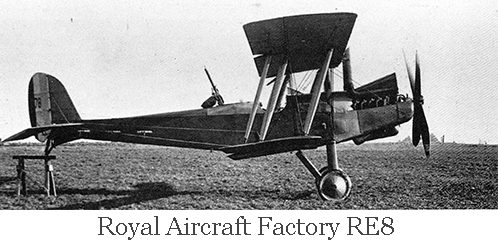 We have already learned that Allan was a bit of an adventurer, so it is perhaps not surprising that he set his sights on becoming a pilot. On 30 April 1917, he reported for flying instruction in Royal Flying Corps Training School at Aboukir, Egypt. He returned to England from the Middle-East on 26 June 1917 and undertook more training. He was appointed to the rank of Lieutenant (Flying Officer) on 19 September 1917.
We have already learned that Allan was a bit of an adventurer, so it is perhaps not surprising that he set his sights on becoming a pilot. On 30 April 1917, he reported for flying instruction in Royal Flying Corps Training School at Aboukir, Egypt. He returned to England from the Middle-East on 26 June 1917 and undertook more training. He was appointed to the rank of Lieutenant (Flying Officer) on 19 September 1917.
But his career as a pilot was tragically short-lived. On 7 November, Allan was formally attached to 7 Squadron, Royal Flying Corps. On the same day he was entrained to France, then on to Belgium where he joined his squadron who were based at Proven West Air Field, arriving on 10 November. Just 2 days later, on 12 November, Allan was piloting Royal Aircraft Factory RE8 No.2255, a British two-seat biplane reconnaissance and bomber aircraft. With him was his Observer, 20 year old 2nd Lieutenant Spencer Leslie Hatton Symonds, from Badwell Ash, Suffolk. Lieutenant Symonds was attached to 7 Squadron from 28th (County of London) Battalion, London Regiment (Artists Rifles), and was showing Allan the lines in the Ypres Salient. A report from the French said the machine had been shot down by anti-aircraft fire and the plane crashed in no-mans-land in front of the French line. The pair were posted as missing; but on 14 November, they were confirmed as being "killed in action" on 12 November 1917. Allan's Observer's body was recovered and is buried in Aeroplane Cemetery, Ieper, West-Vlaanderen, Belgium. Allan's body was not recovered.
| The Times of 21st November 1917 |
KILLED IN ACTION SEWELL - Killed in action, on the 12th Nov., WILLIAM ALLAN SEWELL, Lieutenant, Border Regiment, attached R.F.C., formerly of Keble College, Oxford, youngest son of the Rev. T.J. and Mrs Sewell, of Lynsted Vicarage, near Sittingbourne, aged 23 years. |
| Faversham and North East Kent News of 24th November 1917 |
ROLL OF HONOUR. AIRMAN SON OF VICAR OF LYNSTED KILLED. We have again in record this week the loss of a number of local men, including several more belonging to the Teynham and Lynsted district, amongst these being one of three sons of the Vicar of Lynsted serving in H.M. Forces. |
Allan's death was also announced in the 29 November 1917 issue of "Flight and the Aircraft Engineer" magazine:
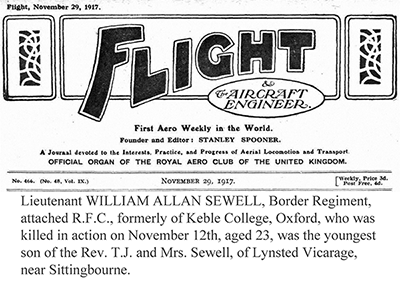
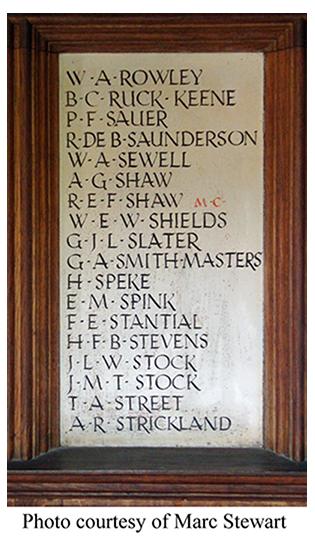 In addition to the Lynsted Memorial, Allan is commemorated on the Arras Flying Services Memorial, Pas de Calais, and on the Roll of Honour at Keble College, Oxford (see panel, left).
In addition to the Lynsted Memorial, Allan is commemorated on the Arras Flying Services Memorial, Pas de Calais, and on the Roll of Honour at Keble College, Oxford (see panel, left).
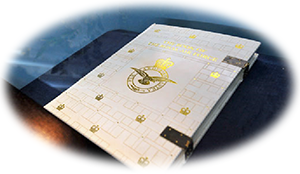
Allan's name also appears in the book of remembrance in St Clement Danes Church, Westminster, the central church of the Royal Air Force. Here are recorded all the names of those killed between 1911 and the present day. He appears in Book 1 (of 10) on the left nearest to the altar. Those who appear in this book pre-date the RAF and include the names of balloonists who served with the Royal Engineers, members of the Royal Naval Air Service and the Royal Flying Corps and RAF personnel killed up to the outbreak of the Second World War.
| Allan is remembered on the grave of his parents and older brother Clarence, in Lynsted Churchyard extension. The inscription reads: | |
| Also in proud and loving memory of their youngest son Lieut. William Allan Sewell of Keble College, Oxford Who, after two years active service with the Border Regiment in India, desiring to share the greatest danger, joined the Royal Flying Corps and was killed in action Nov. 12th 1917 in Houthulst Forest, Belgium. |
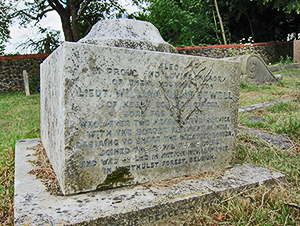 |
Allan was posthumously awarded the British War and Victory medals. [See Appendix 1]
The Story of Allan's siblings
All of Allan's siblings led a life dedicated to church or education. A short biography of Allan's siblings follows:
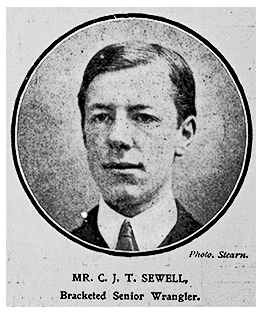 The Reverend Clarence John Threlkeld (Keldie) Sewell was born on 23 April 1884 in Peterborough, where his father was assistant master at The King's School. Clarence was educated at Winchester College and in 1904 went on to Trinity College Cambridge where he was an outstanding student, being elected to an Abbott Scholarship. In 1906 he was bracketed with a Mr Arunachala Tyaga Rajan as Senior Wrangler (the top mathematics undergraduate at Cambridge University, a position regarded as "the greatest intellectual achievement attainable in Britain"). In the following year he was placed in the first-class of the Mathematical Tripos, Part II.
The Reverend Clarence John Threlkeld (Keldie) Sewell was born on 23 April 1884 in Peterborough, where his father was assistant master at The King's School. Clarence was educated at Winchester College and in 1904 went on to Trinity College Cambridge where he was an outstanding student, being elected to an Abbott Scholarship. In 1906 he was bracketed with a Mr Arunachala Tyaga Rajan as Senior Wrangler (the top mathematics undergraduate at Cambridge University, a position regarded as "the greatest intellectual achievement attainable in Britain"). In the following year he was placed in the first-class of the Mathematical Tripos, Part II.
In preparation for Holy Orders, Clarence went to Ripon College, Cuddesdon, Oxfordshire, the largest Church of England clergy training centre. He was ordained in 1910 by the Bishop of Chichester (Dr Ridgeway), with a title to Lancing College, where he was an assistant master.
Sadly, Clarence suffered from diabetes in the days before insulin had been discovered, and on Sunday 17 March 1912, Clarence died at home in Lynsted Vicarage, aged just 27. He is buried in Lynsted Churchyard Extension.
Reverend Arthur Taylor Sewell was born on 23 December 1886 in Smarden, Kent. Like his older brother he was educated at Winchester College and studied Divinity at Bishops' College, Cheshunt. Arthur suffered from being in the shadow of his brilliant elder brother.
In 1925, he married teacher Lucy Ann Marjorie Partridge in Worcester. They had one daughter, Anne who served as a nun in Wantage Convent for 60 years. Arthur served as Vicar at Dundry and Long Ashton, Somerset. He died in Wantage in 1970.
Thomas Jackson Elliott Sewell (known as Elliott) was born in Faversham, where his father was then the Curate, on 25 October 1888. He was educated at Rugby School from Sept 1902 to 1907, and went on to read Mathematics at Queens' College, Cambridge (like his brother before him, he was an Abbott Scholar).
He served as an Assistant Master at Giggleswick School from 1910 to 1911. He then went on to become House Master and Senior Assistant Master at South Lodge Preparatory School, Lowestoft, in 1912.
His time at Lowestoft was interrupted by WW1, when he took up his commission as a 2nd Lieutenant in 122nd Heavy Battery, Royal Garrison Artillery (Special Reserve). He joined his regiment in Contalmaison on the Somme in September 1916.
Elliott was promoted to Lieutenant on 28 March 1918 and mentioned in despatches on 17 May 1918. He was awarded the Military Cross, on 26 July 1918, when serving as Acting Captain. The citation reads:
'For conspicuous gallantry and devotion to duty during an enemy attack, when he fought his section nearly all day under a heavy bombardment, and until he was subjected to severe machine-gun fire from the flank and rear, and had suffered heavy casualties. He then destroyed his guns, only abandoning the attempt to salve them in consequence of the loss of so many horses. His cool and intrepid behaviour throughout was up to the best traditions of the regiment.'
Although already serving as an Acting Captain from 28 September to 6 October 1918, he was raised to Acting Major.
Just 5 days before the Armistice, on 6 November 1918, Elliott was wounded in action, receiving a shoulder wound when commanding a forward section of 60 pounders at St. Waast, near Bavai, Northern France. On 3 May 1919, he was placed on the retired list on account of ill-health caused by wounds and given rank of Captain.
Elliott returned home to his teaching and in 1923 bought South Lodge Preparatory School, Lowestoft, and served as Headmaster. On 2 June he married Elisabeth Georgina Bower, also a teacher, in Huddersfield. They went on to have 3 children. Elisabeth died on 8 January 1945 aged 52.
Elliott oversaw the move of the school, and the change of name, to "Old Buckenham Hall" in South West Norfolk in 1937. Being positioned safely away from air raids, in WW2 it became a refuge for evacuees and a larger intake of boys. During his time as headmaster, the school celebrated its centenary and it celebrated its 150th anniversary just a few years ago. Elliott retired in 1967 and was succeeded as Headmaster by his youngest child, Donald. Elliott died in Sudbury near Brettenham, Suffolk in 1972 on 11 November, Armistice Day.
Reverend Frederick Charles Sewell was born in Faversham in December 1890 and christened by his father on 12 January 1891. Academic success was rated very highly in the family he found life difficult, not being of that bent. After missing out on a university place he left for Melbourne, Australia on 11 February 1920, embarking on the Ulysses from Glasgow.
In 1922 he is recorded as being a "student" at St Peter's Church, Oxley, Queensland. In 1925 he was appointed an assistant curate at Christ Church, Milton, then curate at Ithaca. On 2 February 1926 Fredrick married Mabel Eveline Boldero. They had no children.
His records show an itinerant lifestyle, moving between Gin Gin, Griffiths, Kedron, Ithaca, Auchenflower, Toowoomba and West End - all in Queensland and mainly around Brisbane. This was because Frederick had become part of "The Order of Witness", also known as "The Bush Brotherhood". This was a radical experiment within the Anglican church where they sought to reach the railway construction and mining camps, and the families in the new soldier and immigrant settlements. Bishop Halford had resigned as Bishop of Brisbane and established this order of priests, who lived very simply and were prepared to be sent to live in the camps. The Bush Brothers took a temporary vow of poverty, chastity and obedience. They were either single or had to leave their wives behind during their period of service. They would make periodic returns from the bush to a community house for spiritual replenishment. Their duties included giving religious instruction in schools, holding services and administering sacraments.
In 1948, Bishop Halford died and his obituary notes that, at the time of his death, only one member of the order remained in Queensland, the Rev. F. C. Sewell, then rector of St. Peter's, West End.
On 19 June 1951, he returned to England with Mabel on the "SS Orcades" to visit his family, staying with his brother, Elliott. Records show that they returned to Australia and, in 1959, he is recorded as being Rector in Kedron, Queensland.
Margaret Cecilia Sewell was born in Lynsted Vicarage on 25 June 1892 and christened in Lynsted Church on 24 August the same year. Educated at Cheltenham Ladies College and Cambridge University, she gained an MA in mathematics. Margaret went on to be the Headmistress of Twickenham County School, then St Mary's School, Waverley, Johannesburg, South Africa. She did not marry and died in Nairobi, Kenya, where she was assistant mistress at Kenya High School, on 28 September 1943, aged 51.
Veronica Mary Sewell was born in Lynsted Vicarage on 29 November 1896 and christened in Lynsted Church on New Year's Eve. Veronica was home schooled and during the First World War taught in various preparatory schools. After the war, with coaching from her elder sister, she won a scholarship to Newnham College, Cambridge University, and in 1924 graduated with a BA in mathematics. She enjoyed a successful career as a teacher, ending with 20 years as Head of the Mathematics Department of Wycombe Abbey School. Veronica married solicitor Edwin Ashworth Briggs on 30 April 1927. She died in 1986.
Hannah Dorothy Sewell was born in Lynsted Vicarage on 2 January 1900 and was christened in Lynsted church on 8 February. Hannah became a Sister of Mercy in the Home of the Holy Rood, an Anglican Convent in Worthing. She died in 1984.
| The Society is indebted to Katharine, Allan's niece, daughter of his sister Veronica, for her invaluable assistance in providing a glimpse into the life of the older generation of the Sewell Family. |

 World War 1 Pages
World War 1 Pages